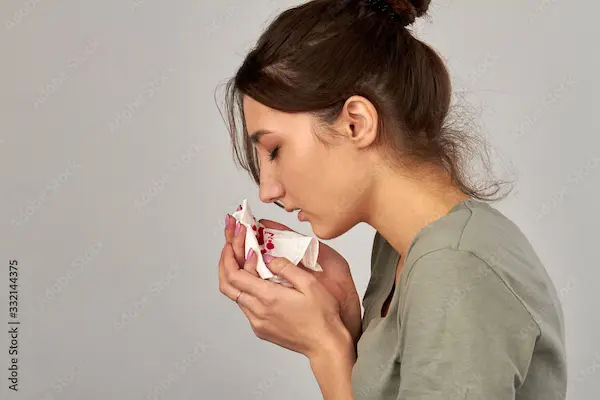Hemoptysis Guide What to Do When You Cough Up Blood
Coughing up blood can be alarming. Learn key causes, red flags, emergency steps, and tests doctors use to diagnose and treat haemoptysis. Know when to seek urgent medical attention and how to prevent recurrence. Get practical first-aid advice and what to expect during a medical evaluation.


Introduction
Seeing blood when you cough can be frightening. The medical term for coughing up blood is haemoptysis, which refers to blood originating from the lungs or airways. It can appear as red streaks in mucus, pink froth, or darker clots. While many causes are mild and treatable, some situations require urgent medical attention—particularly if there is a large volume of blood or breathing difficulty. This guide explains what haemoptysis is, how to differentiate it from blood coming from the nose or stomach, when to seek help, what tests and treatments to expect, and how to lower your risk of recurrence. With timely care, most people recover well. If symptoms persist beyond two weeks, consult a doctor online with Apollo 24|7 for further evaluation.
Consult a Top Pulmonologist for Personalised Advice
What Is Haemoptysis?
Haemoptysis is blood that originates from the lower respiratory tract and is brought up by coughing.
It is important to distinguish it from blood that comes from the mouth or digestive tract.
Haemoptysis vs other sources
• Haemoptysis: Comes from lungs/airways, usually bright red, frothy, mixed with sputum; cough is the main symptom.
• Pseudohaemoptysis: Blood from the mouth or nose appearing in saliva; often linked to a nosebleed or gum problem.
• Haematemesis: Vomiting blood from the stomach; often darker or mixed with food and accompanied by nausea.
What blood in sputum may look like
• Small streaks after intense coughing: often seen in bronchitis.
• Rust-coloured sputum: may occur with pneumonia.
• Bright red clots: suggest more significant bleeding and warrant prompt evaluation.
Even small amounts can indicate an underlying condition, particularly in smokers or older adults. If blood appears repeatedly, arrange an in-person consultation with Apollo 24|7.
When to Seek Help: Red Flags and Emergency Guidance
Large amounts of blood or worsening breathing always require emergency medical attention.
Red flag symptoms — call emergency services if:
• Large volume of blood (e.g., filling a small cup or repeated tablespoons within minutes)
• Breathing difficulty, dizziness, chest pain, or blue lips
• Bleeding is continuous or rapidly returning
• Known lung disease with new bleeding
• On blood thinners with new bleeding
First-aid while awaiting help
• Stay upright or lean slightly forward to prevent choking on blood
• If known, lie on the side of the affected lung to protect the healthy side
• Remain calm; take slow breaths
• Avoid aspirin or non-steroidal painkillers as they may worsen bleeding
What happens in emergency care
• Oxygen monitoring and airway support if necessary
• Blood tests and imaging (usually chest X-ray or CT)
• Suction to clear airways if blocked
• Medication adjustments if bleeding relates to anticoagulants
• Hospital-based treatments for significant bleeding
If symptoms are mild but persist for two weeks or more, seek medical help through Apollo 24|7.
Common Causes Across Age and Risk Groups
Haemoptysis may result from infection, chronic lung disease, heart-related causes, medications, or rarely cancer.
Infections
• Bronchitis or pneumonia: airway inflammation can injure small blood vessels, causing streaks of blood.
• Tuberculosis (TB): a major cause in TB-endemic regions; associated with prolonged cough, fever, night sweats, and weight loss.
Chronic lung conditions
• Bronchiectasis: permanently widened airways trap mucus, leading to recurrent infections and bleeding.
• Chronic bronchitis/COPD: long-term airway inflammation, especially in smokers.
Smoking-related and cancer causes
• Lung cancer may present with persistent cough, chest pain, weight loss, and recurrent haemoptysis. Prompt investigation is crucial in high-risk individuals.
Heart and blood-related causes
• Pulmonary embolism: sudden onset of breathlessness and chest pain with blood-stained sputum
• Heart failure: frothy pink sputum can occur in severe cases
• Blood-thinning medication: increases bleeding risk from minor airway irritation
Special situations
• Children: may aspirate foreign objects — always seek medical review
• Pregnancy: increased vessel sensitivity may contribute to bleeding
Geography influences risk. TB is more common in some regions, whereas chronic bronchitis and cancer are key causes in others.
How Doctors Diagnose Haemoptysis
Diagnosis begins with confirming the source of blood and understanding the underlying cause.
Clinical assessment
Doctors ask about:
• How much blood, how often, and what colour it is
• Breathlessness, fever, weight loss, chest pain
• TB exposure, smoking, medications (especially anticoagulants)
A physical exam includes checking the mouth/nose, listening to lungs, and monitoring oxygen levels.
Key investigations
• Chest X-ray: quick screening for infection, masses, or lung collapse
• CT scan: detailed imaging to find smaller lesions or clots
• Blood tests: to check for anaemia, infection, or bleeding issues
• Sputum tests: identify infection, including TB when suspected
• Bronchoscopy: a camera scope used when bleeding persists or cause remains unclear; can treat bleeding directly
Keeping a note or photo of the sputum appearance and estimated amount can aid accurate diagnosis.
Apollo 24|7 offers home collection for key tests such as CBC and INR where clinically appropriate.
Treatment Options: From Conservative to Advanced
Treating the cause is central to stopping bleeding and avoiding recurrence.
Treating the underlying condition
• Infections: antibiotics for bacterial cases, supportive care for viral illness
• TB: specific multi-drug treatment enables recovery and prevents spread
• Medication-related bleeding: blood thinner adjustments under supervision
Stabilising the airway and bleeding
• Oxygen, IV fluids, and airway suctioning if required
• In selected cases, nebulised tranexamic acid may help reduce bleeding
Bronchial artery embolisation (BAE)
A minimally invasive procedure used to block the bleeding artery.
• Highly effective in emergencies
• Short recovery time, but recurrence varies depending on lung disease severity
Surgery
Reserved for cases where embolisation is not suitable or cancer removal is needed.
Discuss with your care team whether interventional radiology services are available if you are at high risk of recurrent bleeding.
Understanding Severity: How Much Blood Is “Too Much”?
Volume, speed of bleeding, and breathing safety guide urgency.
Estimating blood volume
• Teaspoon ≈ 5 mL
• Tablespoon ≈ 15 mL
• Medicine cup ≈ 30 mL
Filling a small cup or repeated tablespoons over a short time is concerning.
Massive haemoptysis
Often defined as over 100–200 mL in 24 hours, OR any bleeding causing breathing failure.
This is a life-threatening emergency.
Tracking timing, volume, associated symptoms, and possible triggers will help clinicians assess severity quickly.
Living With and Preventing Recurrence
Control triggers, treat infections early, and protect airway health.
Daily care strategies
• Stay well hydrated and use cool-mist humidifiers
• Keep vaccinations up to date (flu and pneumococcal)
• Avoid irritants like cigarette smoke and pollution
• Practise airway clearance exercises if advised for bronchiectasis
Stopping smoking is the most powerful step for reducing recurrence risk in smokers.
A cough diary noting changes in sputum colour or breathlessness helps detect flare-ups early.
Special Situations and FAQs
Tailoring care to different conditions ensures better outcomes.
Taking blood-thinning medicines
Do not stop medicines without medical advice — dose changes may be required for safety.
Haemoptysis after COVID-19
Sometimes, due to lingering airway inflammation, persistent symptoms need follow-up to exclude other complications.
TB risk
If prolonged cough, fever, and blood in sputum occur after travel or exposure, get tested promptly.
If symptoms continue beyond two weeks, consult a doctor online with Apollo 24|7 for further guidance.
Preparing for a Medical Appointment
Good preparation speeds up accurate diagnosis and treatment.
What to bring
• Medication list and previous reports
• Notes or photos showing the amount of blood
• Timeline of symptoms, including fever or weight changes
Helpful questions to ask:
• What is the likely cause of my haemoptysis?
• Which tests do I need first?
• How can I prevent recurrence?
Non-urgent labs such as CBC or INR can be organised through services like Apollo 24|7 home collection when appropriate.
Case Snapshots
Real-world examples help explain decision-making.
• Older smoker: morning streaks lead to CT confirming early bronchiectasis → smoking cessation and airway clearance reduce episodes
• TB-exposed traveller: prolonged cough with night sweats → TB treatment resolves symptoms
• Blood thinner patient: high INR causing bleeding after infection → controlled medication adjustment and monitoring improve safety
Conclusion
Haemoptysis—coughing up blood—can be alarming, but understanding what it means and how to respond can keep you safe. While many causes are mild and treatable, you should always take bloody sputum seriously. Emergency symptoms include rapid bleeding, difficulty breathing, or dizziness. These require urgent medical care. Doctors diagnose haemoptysis by identifying the source of bleeding and investigating causes using scans, blood tests, and sometimes bronchoscopy. Treatment depends on the underlying condition and may include antibiotics, TB care, blood thinner adjustment, or interventional radiology procedures such as bronchial artery embolisation. To reduce recurrence, avoid smoking, manage lung conditions proactively, stay up to date with vaccinations, and treat respiratory infections early. Keep track of symptoms and any bleeding episodes to support an accurate medical assessment. If symptoms persist beyond two weeks or you are unsure what to do, consult a doctor online with Apollo 24|7 for personalised medical advice, or arrange a clinic visit. With prompt evaluation and proper care, most people recover well and maintain better lung health moving forward.Consult a Top Pulmonologist for Personalised Advice
Consult a Top Pulmonologist for Personalised Advice

Dr. Mahavir Bagrecha
Pulmonology Respiratory Medicine Specialist
14 Years • MBBS, MD (PULMONOLOGY)
Pune
Swash Chest and Diabetes Clinic, Pune
(50+ Patients)

Dr. Mary Susan K S
General Physician/ Internal Medicine Specialist
13 Years • MBBS, MD INTERNAL MEDICINE
Bengaluru
Apollo Clinic, Sarjapur Road, Bengaluru
(25+ Patients)

Dr. S Mallikarjun Rao
Pulmonology Respiratory Medicine Specialist
22 Years • MBBS, MD (Pul.), FCCP
Hyderguda
Apollo Hospitals Hyderguda, Hyderguda
(75+ Patients)

Dr Abhishek Verma
Pulmonology Respiratory Medicine Specialist
5 Years • MD (Respiratory Medicine), PDCC (Interventional Pulmonology) Alumni SGPGIMS & KGMU Lucknow
Lucknow
Apollomedics Super Speciality Hospital, Lucknow
(50+ Patients)

Dr. P Sravani
Pulmonology Respiratory Medicine Specialist
3 Years • MBBS, MD
Visakhapatnam
Apollo Clinic Vizag, Visakhapatnam
Consult a Top Pulmonologist for Personalised Advice

Dr. Mahavir Bagrecha
Pulmonology Respiratory Medicine Specialist
14 Years • MBBS, MD (PULMONOLOGY)
Pune
Swash Chest and Diabetes Clinic, Pune
(50+ Patients)

Dr. Mary Susan K S
General Physician/ Internal Medicine Specialist
13 Years • MBBS, MD INTERNAL MEDICINE
Bengaluru
Apollo Clinic, Sarjapur Road, Bengaluru
(25+ Patients)

Dr. S Mallikarjun Rao
Pulmonology Respiratory Medicine Specialist
22 Years • MBBS, MD (Pul.), FCCP
Hyderguda
Apollo Hospitals Hyderguda, Hyderguda
(75+ Patients)

Dr Abhishek Verma
Pulmonology Respiratory Medicine Specialist
5 Years • MD (Respiratory Medicine), PDCC (Interventional Pulmonology) Alumni SGPGIMS & KGMU Lucknow
Lucknow
Apollomedics Super Speciality Hospital, Lucknow
(50+ Patients)

Dr. P Sravani
Pulmonology Respiratory Medicine Specialist
3 Years • MBBS, MD
Visakhapatnam
Apollo Clinic Vizag, Visakhapatnam



